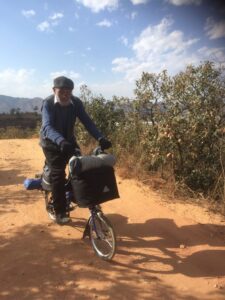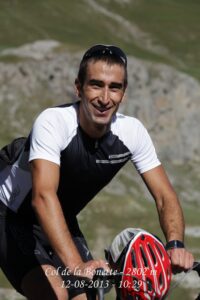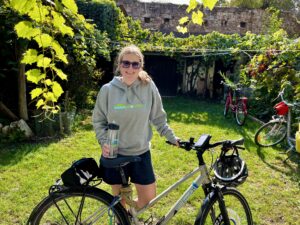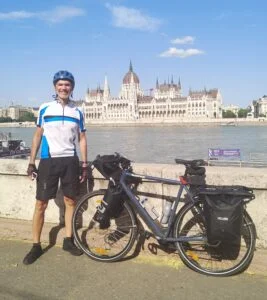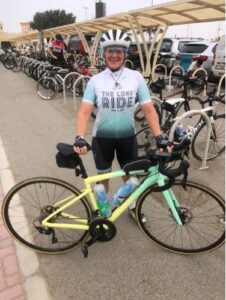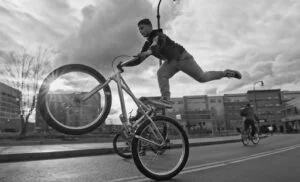Contributor: Filmed by Bike

Have you ever had the experience of being on your bike during an adventure, knowing you were witnessing sights and sinking into moments so rare and special?
For some of us, we’re pulled to document the journey and share this experience with others. Once upon a time in an era not too long ago, people would take photos along the way during their bike tours and host a low tech slideshow-and-tell viewing party afterwards. While those tour recaps do still exist, these days people are opting for increasingly sophisticated ways of documenting their experiences, such as a blog or even a documentary film.
Just what does it take to create a film about your bike tour? Do you need special skills or equipment? We turned to an expert on this topic to find out.
Ayleen Crotty is the Founder and Festival Director of Filmed by Bike, a film festival that features the world’s best bike movies. The festival has been around for 19 years, and Ayleen has seen more than her fair share of bike films. Though Filmed by Bike showcases all genres of films, from love stories to comedies, documentaries to animations, Ayleen says the most prevalent of films are those that feature amazing feats of adventure by bike.
Ayleen says the festival is always seeking stories that have yet to be told, or ways of sharing a story that are unique, creative or particularly moving. Every year the festival receives several hundred film submissions from all over the world and a jury of bike and film enthusiasts selects about 60 films for the festival. Many of those submissions are strikingly similar, so films that stand out are more likely to make the cut.
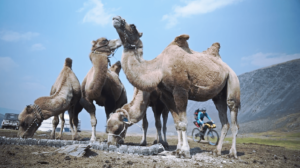
Sharing the journey isn’t hard at all, Ayleen explains. What is hard though, is taking the time to create an entertaining film that will captivate the audience. “Often, little details are overlooked. Though it takes time, it really doesn’t take much expertise to sweeten your film into a very special piece.”
Here’s Ayleen’s quick guide for turning your bike tour footage into a stunning film.
EQUIPMENT
You don’t need fancy equipment to capture stunning footage. But if you know how to use the better equipment, you’ll be able to do more with your camera. Opt for something compact lightweight whenever possible.
Consider the conditions you’ll be undertaking, such as bumpy roads, dust and rain.
A phone with an excellent camera can sometimes be the perfect solution.
Consider multiple camera options, such as mounting a GoPro on your helmet. This will help you capture different angles and moments that you may not otherwise be able to film.

CAPTURE THE SHOT
Sink in and enjoy your ride! But if you truly want to make an excellent film, always be ready to capture the shot. It’s always better to have more footage.
Double back if you have to. If you’re pedaling along thinking “I really should have gotten that shot” then go back for it. But keep yourself in check; if you’re not careful, you could spend all day doubling back and never get anywhere!
A sweeping landscape is beautiful, but a rider moving through that landscape makes for a more interesting film moment. Set your camera on the ground and film yourself riding across the landscape. Review your footage to see if you got the shot you had in mind. Over time, you’ll develop your own personal efficient system for capturing these shots.
The backside of someone is not nearly as interesting as a face. Get ahead and shoot back to capture the person’s face.
When in doubt, just shoot. Even if you can’t get the conditions just right, sometimes that little moment might be just what you need to round out the piece in the editing process.
TELL A STORY
Why should the viewer care? Paint a picture and tell a story. Give the viewers context, and take them on a journey. At Filmed by Bike, we see hundreds of bike adventure films. The ones with a story always stand out.
Storyboard your film. This means writing your film’s story and the details from start to finish. I recommend doing this before you leave on your adventure to give you a sense of how you might capture certain tricky moments, but also be willing to completely scrap that plan and tell an entirely different story. After all, we never know exactly how these adventures will go, do we? And that’s precisely why we go out there in the first place!
When editing, remember that your film does not need to be a linear explanation of what happened from the beginning of your journey to the end. Think about some of your favorite books and movies – how they jump around in time.
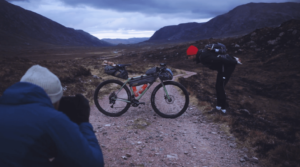
INTERACT WITH THE WORLD AROUND YOU
First and foremost, be respectful of the people, animals and land around you. As visitors, we must learn about where we are adventuring.
Across the world, much of the land where we adventure is stolen land – land that was taken from the people who originally lived there. Consider adding titles to your film that mention where your film takes place not only by the common modern name, but also the name of the people whose land it once belonged to.
As you’re filming, interact with the people, animals and land around you. Show the viewers how you were experiencing this world.
Have respect for the people you film, and always ask permission first.
EDITING YOUR FILM
Editing is a long process. The more you edit, the better your film will be. Don’t stop after your first cut! You captured amazing footage – take the time to make your film amazing, too!
Organize your footage, then make a rough cut of the story you think you want to tell. Watch it a few times, make some changes, then let it sit for a while. Come back to it later, and make more edits. Continue this process until you feel you have a great piece that truly represents your journey and the story you want to tell.
Invite a trusted friend or advisor to view the film and offer honest feedback.
Take your ego out of the process, focus on what will make a great film. Remember that your viewers weren’t there alongside you; they didn’t experience this journey.
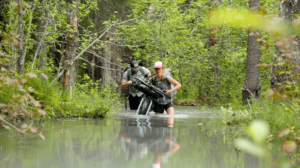
Now comes the hard part: Cut out everything you can. Trim the film down as much as you can. There may be elements of the film you are personally attached to, but if they do not contribute to the overall story, if they do not move the viewer or make the film better, cut them out. Cut out everything that does not does not drive your film forward and make it amazing.
And finally, add some tiles and credits! There are endless ways to approach your titles so have fun with them.

